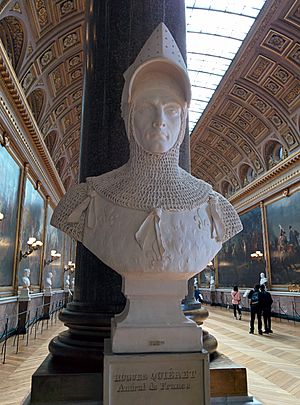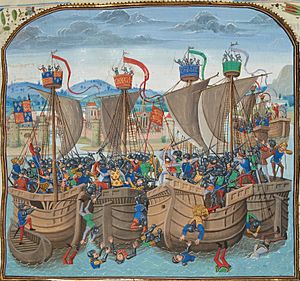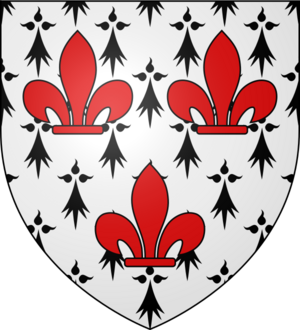Hugues Quiéret facts for kids
Quick facts for kids
Hugues Quiéret
|
|
|---|---|
| Admiral of France | |
 |
|
| Born | c. 1290 |
| Died | 24 June 1340 (aged 49–50) off the coast of Sluys |
| Wars and battles | |
| Offices | Grand Master of France |
Hugues Quiéret (born around 1290 – died June 24, 1340) was a French nobleman and a military leader. He was a knight and owned lands in Picardy, France. Before becoming an admiral, he served as an advisor and a high-ranking official in the king's household. He was also in charge of the regions of Beaucaire and Nimes from 1325 to 1332.
Later, Hugues Quiéret became an Admiral of France. He won several battles at sea. In 1340, he led the French fleet at the Battle of Sluys during the Hundred Years' War between France and England. He was hurt, captured, and then killed by the English.
Contents
Hugues Quiéret's Family Background
Hugues Quiéret's father was also named Hugues. He was a knight and a lord. The Quiéret family came from a noble background in Picardy. Their family symbol, called a coat of arms, showed three golden lily flowers on a white background. It also had two lions as supporters. This design came from Hugues Quiéret's marriage in 1312 to Blanche d'Harcourt.
Blanche's grandfather, Jean II d'Harcourt, was a famous military leader. He was a Marshal of France and one of the first Admirals of France. Hugues and Blanche had several children together.
Hugues Quiéret's Career and Roles
Serving as a Sénéchal
Hugues Quiéret was made the sénéchal of Beaucaire and Nîmes. A sénéchal was like a governor or a chief officer in charge of a region. Beaucaire was an important port for ships. In this role, he helped escort important people. He was also involved in a war in Gascony in 1326.
Becoming an Admiral of France
In 1335, King Philip VI of France changed how the Admiral of France position worked. It was now given to important French nobles like Quiéret. However, he wasn't the top commander of the entire French fleet. He worked under another high-ranking officer.
Quiéret was very good at organizing the navy. He helped improve the shipyards and arsenals (places where ships are built and repaired) in places like Harfleur and Rouen. These improvements were important for building up the French fleet.
Planning an Invasion of England
In 1338, France planned a large invasion of England. French provinces promised to provide ships for this big attack. The goal was to transport 4,000 soldiers to England. This force was called the Grand Army of the Sea.
Preparations for this invasion happened in Harfleur and Leure. Leure was a major port that provided many ships for the French fleet. During these preparations, it was recorded that the French fleet used gunpowder. This was one of the first times French naval ships used artillery (cannons). Quiéret also led raids on English towns like Southampton and burned ships in Bristol and Plymouth.
The Battle of Arnemuiden (1338)
The Battle of Arnemuiden was a naval fight on September 23, 1338. It happened at the start of the Hundred Years' War. A large French fleet, led by Admirals Hugues Quiéret and Nicolas Béhuchet, fought against five smaller English ships. These English ships were carrying wool to an ally of England.
The battle took place near Arnemuiden in the Netherlands. The English ships were outnumbered. They fought bravely, especially the ship Christopher, which had three cannons and a hand gun. This battle was the first time cannons were used in a European naval battle. The English commander, John Kingston, only gave up after fighting all day. The French captured the valuable cargo and the English ships. Sadly, the French killed the English prisoners after the battle.
The Battle of Sluys (1340)

On June 24, 1340, the Battle of Sluys took place. It was in the Zwin estuary, an arm of the sea that led to the city of Bruges. This was the first major battle of the Hundred Years' War. The French fleet was much larger than the English fleet, which was led by Edward III of England.
The French fleet had about 30,000 men. It included many galleys with experienced sailors from Genoa, Italy. It also had merchant and fishing ships turned into warships. The English had about 150 ships and 15,000 soldiers. Quiéret and Béhuchet commanded the French fleet. Their main job was to make sure the French army could cross the sea safely. They chained their ships together to form a strong line across the water.
The English attacked at midday. The French crossbowmen fired first, but the English longbowmen were faster. Soon, there was fierce hand-to-hand fighting. Quiéret and Béhuchet tried to surround Edward's ship. Some stories say Quiéret drowned during the battle. Other accounts say he was captured by the English. Despite his injuries, he was immediately killed by the English. This was done in revenge for the English prisoners who were killed at Arnemuiden two years earlier. His body was then thrown into the sea.
The battle was a huge defeat for the French. Many French soldiers were killed, and their fleet was almost completely destroyed.


